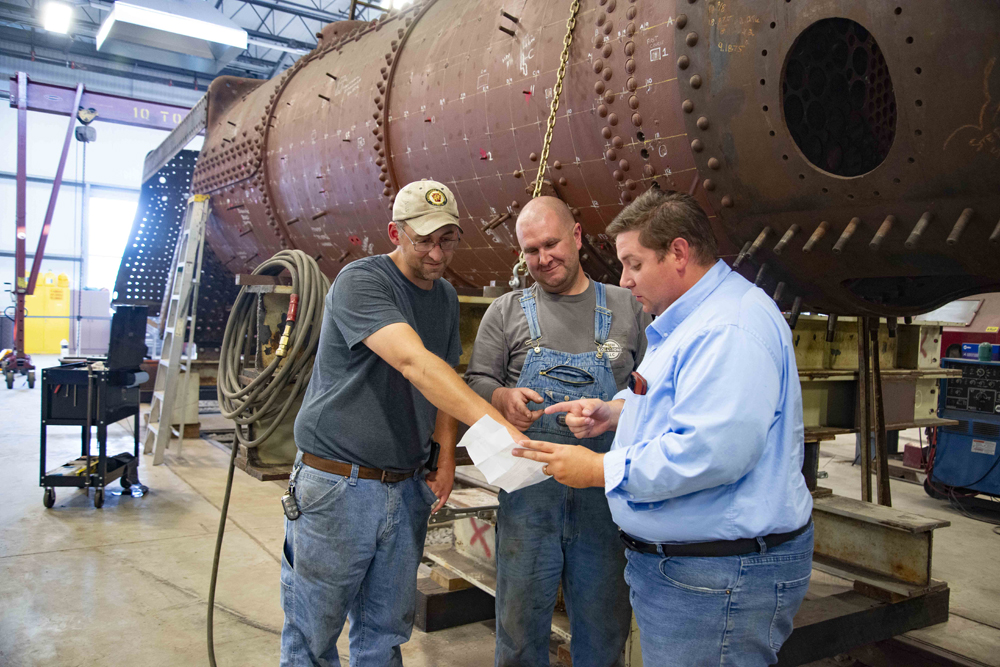
ALTOONA, Pa. — Work to construct a new $425,000 firebox for Pennsylvania Railroad Class K4s steam locomotive No. 1361 (PRR Juniata Shops, 1918) is moving along rapidly, with the inner wrapper sheets scheduled to be assembled late next month or in early September.
The locomotive is in the midst of a $2.6 million restoration to operating condition under the management of its owner, the Railroaders Memorial Museum. Consulting engineers FMW Solutions of Soddy Daisy, Tenn., recommended that the museum replace the PRR-built firebox, which falls short of current Federal Railroad Administration pressure-vessel safety standards.
In a funding campaign started in 2021 [see “PRR K4s engine No. 1361 to be restored …,” Trains News Wire, June 25, 2021], the museum raised the money needed to fabricate a new firebox, the rear part of the boiler that uses heat energy to convert water into steam to power the cylinder-propelled driving wheels. The money came from large and small donors, a $100,000 grant from the Pennsylvania Railroad Technical & Historical Society, and benefit steam excursions on the nearby Everett Railroad and the Western Maryland Scenic Railroad in Cumberland, Md. For those events, the three-chime PRR Blue Ribbon passenger whistle from No. 1361 was fitted to the steam engines on each of those roads.
No. 1361 is one of just two surviving K4s engines from a fleet of 425 built between 1914 and 1928 by Juniata Shops in Altoona (350 engines) and Baldwin Locomotive Works (75 engines). For 30 years, the class served as PRR’s primary passenger power.
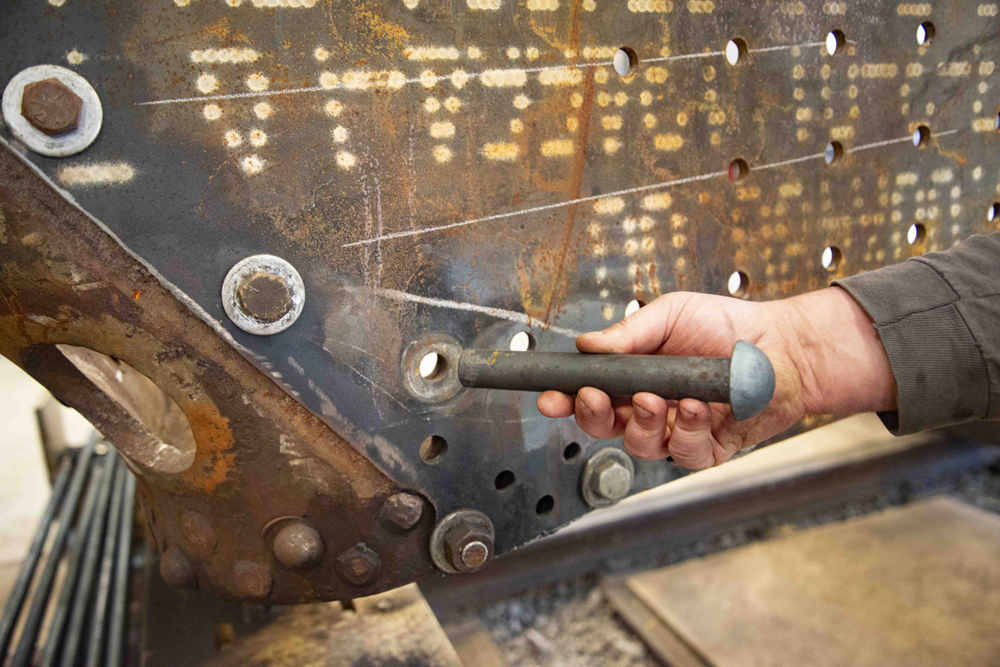
The outer firebox wrapper sheets are formed and drilled for rivets and staybolts, and the fireman’s-side piece is temporarily fastened to the boiler barrel with bolts. The engineer’s-side outer sheet was fitted and then removed to facilitate the installation of the six inner-sheet parts.
The new crown and side sheets are being fabricated at Greiner Industries in Mount Joy, Pa., according to Zach Hall, FMW general foreman, and will be delivered to Altoona in a few weeks. The new door sheet and original inner throat sheet are at FMW’s shop for patchwork and will be delivered in late August or early September.
Although PRR called itself the “Standard Railroad of the World,” some of its engineering standards – duplicated on thousands of PRR steam locomotives – were anything but customary. Two examples are the use of a squared-off firebox style called the Belpaire design, and the use of left-hand quartering on the driving-wheel crank pins. Most American railroads used a standard radial-top boiler, and a right-hand lead on the crank pins, which transmit energy from the cylinders into circular motion, turning the 80-inch-diameter driving wheels.
Both quirks increased the cost and complexity of restoration, but Hall says that with the help of computer-aided design and careful attention to double- and triple-checking specs, the obstacles can be overcome. “It’s still a steam engine at the end of the day,” he said.
The design, fabrication, and assembly of the new firebox is “the largest single aspect of the budget,” according to Joe DeFrancesco, the museum’s executive director. When the pieces are put together in the museum’s roundhouse late next month or early September, he said, visitors will be able to intermittently watch the progress from a safe viewing area.
The exception will be when a group of about a half-dozen workers, both FMW staff and volunteers, are driving the hundreds of rivets and staybolts, hammering pieces, or using impact wrenches. All are ear-splitting procedures requiring robust hearing protection, so the shop will be closed during those sessions.
As the firebox reaches completion, DeFrancesco said, the museum will start its campaign to raise several hundred thousand dollars for the next phase — developing a budget and work scope for mating the boiler and firebox to the frame and running gear. This, he said, will include installation of the six drivers and the leading and trailing trucks. He repeated earlier advice offered by board Chairman Wick Moorman that the best way to support the project is to buy a museum membership.
The lead volunteer working on the 1361 is Mike Reindl, an employee of Norfolk Southern’s Juniata Locomotive Shop whose day job is overseeing diesel-locomotive emissions testing. Others are Andy Charlesworth, Tom McKelvey, and Brandon Sliko, as well as Dick Charlesworth and Joe Harella of the Horseshoe Curve Chapter of the National Railway Historical Society,
Restoration work under way on observation car
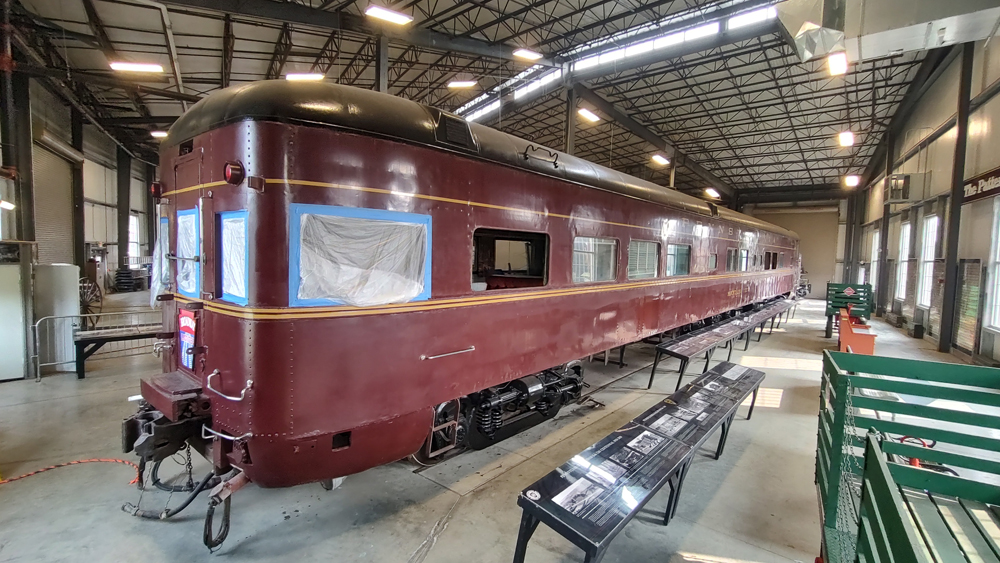
Across the shop floor from the steam engine sits the museum’s newest restoration project, the Mountain View, a Pullman-built blunt-end streamlined observation car constructed for the 1949 version of the Broadway Limited. Inaugurated in 1902 under a different name, the Broadway was PRR’s premier overnight all-Pullman New York-Chicago flyer. The postwar order represented the train’s final re-equipping with new rolling stock.
Work has been under way for about six weeks, aided by an Emery Rail Heritage Trust grant of $13,000 to replace windows and gaskets to make the car FRA Part 223-compliant. This will eliminate condensation that formed in some of the double-paned glass sections. The near-term goal, DeFrancesco says, is to make the car runnable for tourist service, adding: “We’d like to see it bring up the markers behind the K4.”
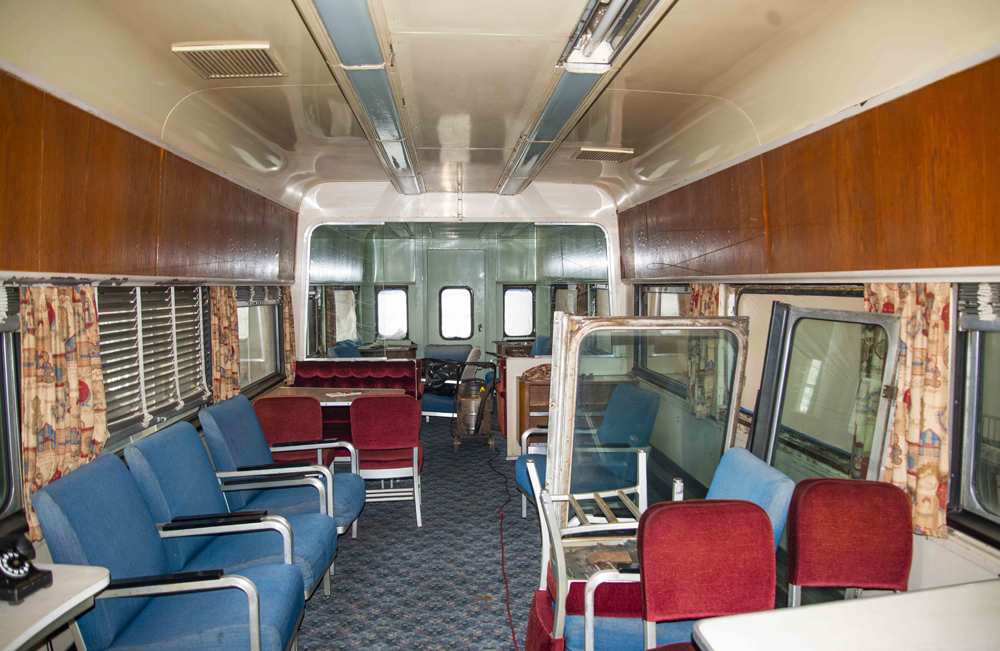
Overall, the work will cost about $80,000, he said. Longer term, the goal is to make it Amtrak-compatible. Both for tourist service lease and on Amtrak, the dual goal is to make it a showpiece that is also capable of earning revenue.
FMW is also consulting on this project, and among the work needed, Hall said, is replacement of the car’s two main air reservoirs. Its air-brake valves need to be updated and cleaned. The car is already equipped with a 480-volt electrical system. The interior is not in bad shape, but needs a good cleaning to rid it of a musty, old-carpet smell, he said.
Minor body work is needed, he said, and the restoration crew will need to ensure that the air-conditioning and toilet retention systems work flawlessly. The wheel tread and profile are in good shape, he said, but rebuilding of its trucks would be required to bring it into compliance with Amtrak standards.







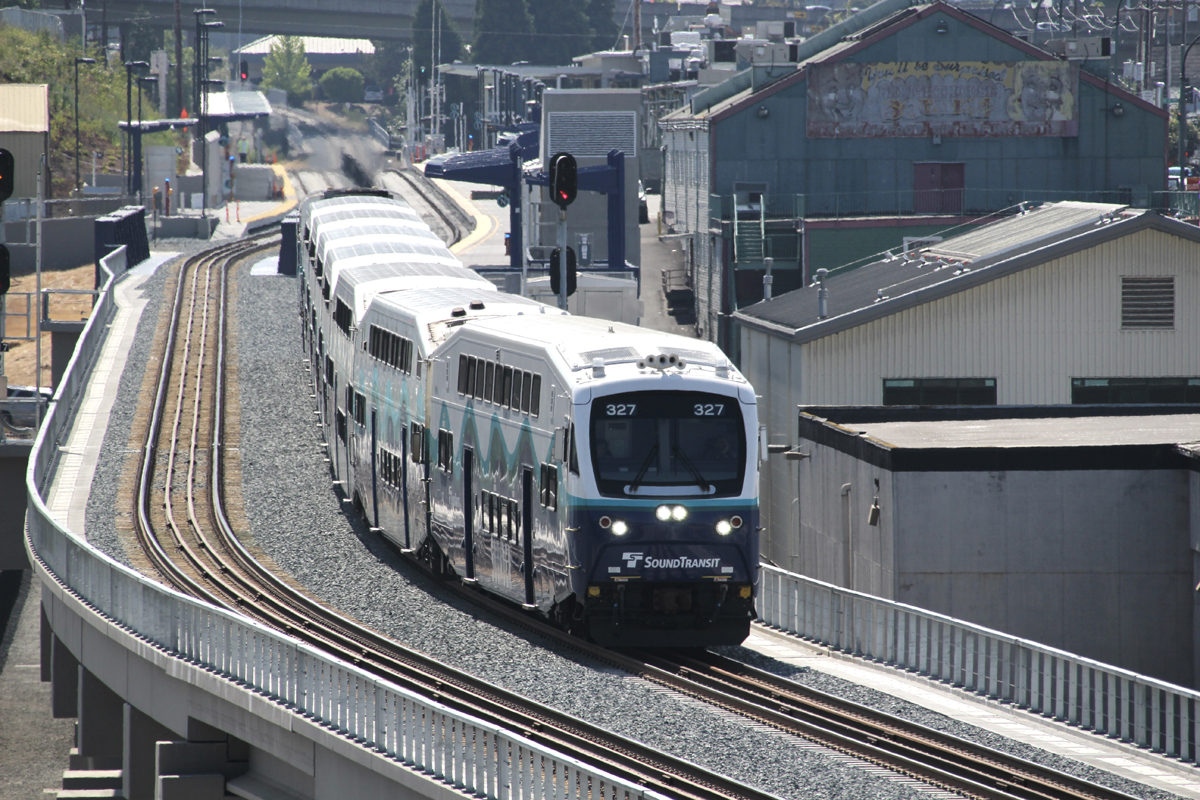






I grew up in Altoona. I have been to the museum and the Curve numerous times.
I am old enough to remember having ridden behind K-4s on several occasions.
I am under the impression, perhaps wrongly, that having a diesel behind the steam engine is for electrical power to the cars and for help with braking? Is this true?
Speaking of fire boxes, I’m looking forward to the day, (if I live long enough at my age of 77, lol), of the development of safe(r) molten salt, liquid fluoride thorium reactors (LFTR) that theoretically could be downsized as a heat source for a steam locomotive, negating the need for coal or fuel oil, (and perhaps even wood in the antiques). And of course that LFTR technology could also supply thermal heat fuel for strategically located generator powerhouses for catenary railroad operations.
https://www.youtube.com/watch?v=WWUeBSoEnRk
This is the third restoration for the 105 year old PRR 4-6-2 K4 “Pacific” No. 1361. Long may it live and run on the shining steel tracks!
Dr. Güntürk Üstün
The 103 year old PRR K4 No. 3750 sits on outdoor static display at the Railroad Museum of Pennsylvania, outside Strasburg, Pennsylvania. The museum’s volunteer group plans to have No. 3750 cosmetically restored prior to it being placed in the newly proposed roundhouse exhibit.
Dr. Güntürk Üstün
I once rode at mph on a train with double headed K4’s. I was with my family on a trip from Chicago to Cincinnati and it had been delayed due to the Calumet River bridge being opened for a boat. After the train got down of the connection to the double track main line to Logansport, my father & I went to the vestibule of the rear car and he used his watch on the mile posts and saw we were at 100 mph. This was in 1943. Will never forget it.
Established in 1980, the Railroaders Memorial Museum (RMM) focuses on the history of railroad workers and railroad communities in central Pennsylvania, particularly Altoona, the Altoona Works, and the greater Pittsburgh area. Since 1998, the museum has been located in the Master Mechanics Building, built by the Pennsylvania Railroad in 1882. The museum also operates a separate museum, visitor center, and observation area at the Horseshoe Curve.
Dr. Güntürk Üstün
Why not a cosmetic repair since it’ll be pushed by a Diesel anyway?
No it won’t. It will actually do the work. A diesel may be included in the consist but only in case of failure of the steam engine. As is the case for most all steam engines that are working for heritage museums. The Big Boy also does all the work when it is out and running. It even has all the electronic and computer equipment to run on signal tracks. Yes a diesel is in that consist as well but it is in standby mode.
Sorry… But, I would have to see to believe. That’s a lot of dead weight for a steam locomotive to haul as an expensive “insurance policy”, in addition to passengers and such. I suggest looking at the recent example of where the restored Big Boy had to recently aid a stuck Diesel freight. The pros who do restorations for a living should be acknowledged for the quality of their work.
The Broadway Limited was not named for the street in NY City (or the one in Camden NJ) but for the PRR’s Broad Way: its 4-track Main Line
I never knew that!
Formerly 4-track… Horseshoe Curve has been three tracks for ages.